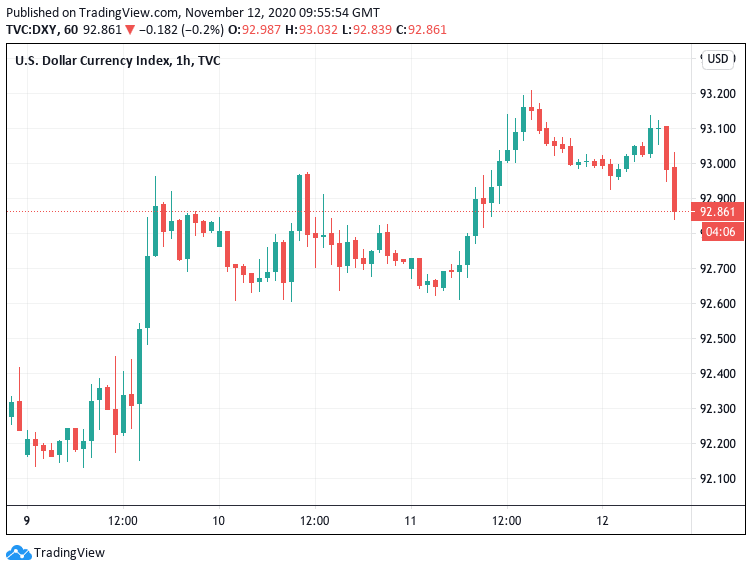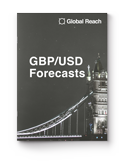Why the U.S. Dollar has been a Vaccine News Winner
- USD aligning itself with stock markets
- Has gone higher on vaccine news
- Market sentiment softens following Monday's boost
- Traders eagerly await 'silver bullet' candidate from AstraZeneca

Image © Adobe Stock
- GBP/USD spot rate at time of publication: 1.3196
- Bank transfer rate (indicative guide): 1.2830-1.2920
- FX specialist providers (indicative guide): 13060-1.3077
- More information on FX specialist rates here
Has the Dollar's reaction function to risk been flipped by this week's vaccine news? Financial market price action in the wake of news of a potentially successful covid-19 vaccine from Pfizer, and subsequent news from Moderna, suggests that instead of being a loser amidst an air of improved investor expectations, the Dollar could be a winner.
Initial reactions by the analyst community suggest this relationship shift could be down to a shift in expectations for further Federal Reserve support, which in turn imperils a widely-held view amongst analysts that the Dollar is due to enter a long-term period of decline.
"The usual drill nowadays is for the dollar to fall on risk-on days, but that didn’t happen yesterday. I think that has to do with expectations that with a vaccine appearing, the Fed won’t have to ease policy as much as had been expected," says Marshall Gittler, Head of Investment Research at BDSwiss Group.
The Dollar index - a measure of broad Dollar performance - has risen 0.68% in the week thus far, a move that is odds with the significant jump in global equity markets that accompanied the rapid improvement in sentiment to Pfizer's news on Monday that their vaccine candidate is 90% effective.
The news sent investors rushing into stocks while the Dollar and other 'risk off' currencies initially fell on the news.
But, the Dollar promptly overturned this vanilla reaction and flipped to go higher against the Euro, prompting a loss of 0.50% in the Euro-to-Dollar exchange rate, with further losses materialising over subsequent days ensuring the pair is 0.70% lower this week.

Above: The Dollar index has gone higher since Monday's vaccine news.
"Government bond yields rose, cyclical currencies rose and the gold price dropped. EUR/USD barely moved because the 10y US Treasury yield and 10y German Bund yield both rose. Afterwards the dollar edged higher as the yield spread increased in favour for the dollar," says Georgette Boele, Senior FX Strategist at ABN AMRO.
The yield paid on government bonds in the U.S. are therefore at play, and this yield is in turn impacted by shifting expectations regarding future interest rates and policy at the Federal Reserve.
In particular, the vaccine news implies a stronger economic recovery in 2021 onwards, which in turn means the Fed can bring forward its next rate hike.
Indeed, Gittler notes money markets are becoming more attuned the three-year/1 month fed funds swap rate which has hit 0.39%, indicating that the market is expecting at least one and maybe two rate hikes over the next three years.
"I would doubt that under the Fed’s new inflation-averaging regime, but that’s what the market is thinking," says Gittler.
A general rule of thumb up until this week as been the Dollar rises when markets are falling and falls when the opposite is true, courtesy of its 'safe haven' status.
This week has seen risk flip into positive territory, that suggests the Dollar would be primed to head lower were the traditional relationship with risk reassert.
"At -0.13 (vs 0.42 last week) our Risk Index has moved back into risk seeking territory for the first time since early March. Reduced political uncertainty as related to the US and more positive vaccine newsflow on the Covid-19 front have been driving the latest development," says Manuel Oliveri, FX Strategist at Credit Agricole.
Expectations that an end to the covid-19 crises were raised mid-week after biotech firm Moderna said it is now in a position where it can start to analyse the results of its clinical trials.
The Moderna vaccine uses a similar mRNA technology to that of the Pfizer-BioNtech vaccine, which means it is also has a good chance of being highly effective and is already being mass produced in anticipation of approval.
"Vaccines are coming. There is a weird narrative conflict right now as COVID-19 is at its worst point and getting much worse quickly while the vaccine timeline and efficacy stories look suddenly better. I would bet that the negative from the current wave of COVID, no matter how bad this wave is, will be overwhelmed by the positive of vaccine optimism because the current wave is temporary and the end of COVID-19 will be permanent," says Brent Donnelly, Spot FX Trader at HSBC.
"Therefore, I would think that the vaccine theme is a durable one and the rotation out of virtual into real is sustained," adds Donnelly.
{wbamp-hide start}
GBP/USD Forecasts Q2 2023Period: Q2 2023 Onwards |
"Outperforming non-defensive sectors such as utilities also suggest that investors have become more confident in the risk rally having legs, which suggests any corrective downside from here may be quickly met with new demand," says Oliveri.
Equity markets - and the Dollar - are however trading softer on Thursday, as the rally that ripped through markets on Monday, causing the majority of retail trading platforms to suffer failure, pauses.
That the Dollar is tracking markets lower is in itself further confirmation of a short-term shift in the currency's relationship with risk and markets.
Market participants have now had time to digest news from Pfizer while the news from Moderna appears to have had little impact.
Indeed, there is a possibility that the 'big news' on vaccines will ultimately come from the AstraZeneca-Oxford University vaccine candidate, which is a simpler and cheaper prospect.
The Pfizer vaccine - and by extension the Moderna vaccine, owing to their similar mRBA technology - look to be incredibly challenging candidates to roll out in a mass vaccination programme, due to 1) its cost and 2) the temperatures it must be stored at.
1) The cost of the Pfizer vaccine is said to be around the £29.47 mark for two doses, which contrasts to the £2-3 being cost being touted for the AstraZeneca candidate.
2) The Pfizer vaccine must be stored at around -70c, which makes for a significant and expensive logistical challenge when it comes to roll out.
This is why the AstraZeneca really could be the 'silver bullet' the world needs - for sure, developing countries can only really expect to roll out a vaccine that is both cheap and robust.
Yet again though, the UK's small geographic size, population density, pre-planned rollout programme and significant budget dedicated to the Pfizer vaccine and its rollout means it is a viable candidate.
The UK, its economy and currency could therefore find itself in an advantageous scenario relative to other countries in a scenario where the Pfizer vaccine is rolled out but the AstraZeneca vaccine disappoints.
"With ten vaccine candidates in late-stage trials globally and encouraging vaccine efficacy data our central scenario is that restrictions can start to be lifted by early 2021, helping corporate earnings recover to pre-pandemic levels by around the end of 2021," says Thomas Flury, Strategist with UBS in Switzerland.





